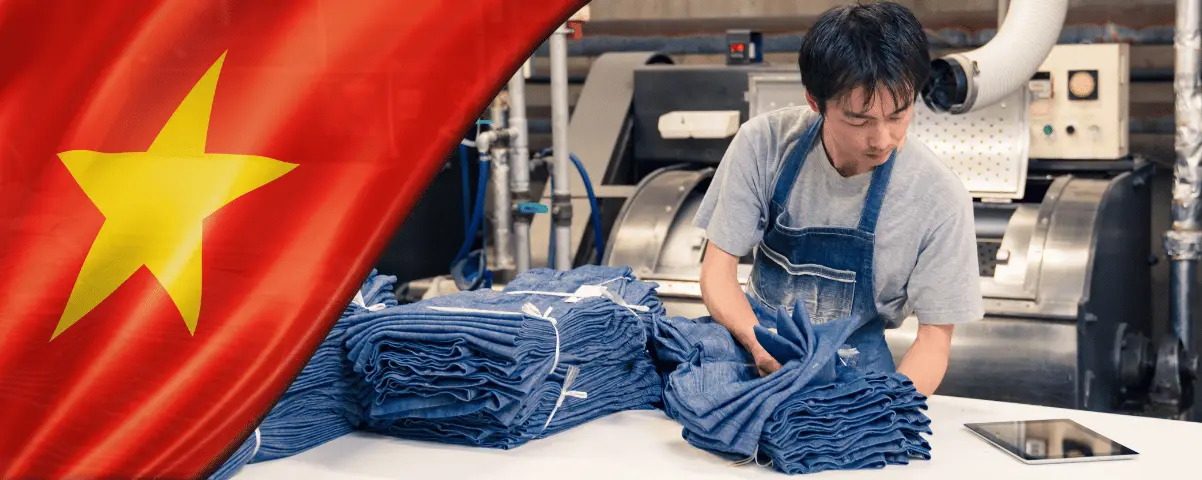Rising Star: Overview of Vietnam’s growing textile and garment industry
Introduction
In recent years, Vietnam has emerged as a rising star in the global textile and garment industry. With a rich history deeply rooted in the art of textile craftsmanship, Vietnam has rapidly transformed into one of the world’s key players in this sector.
The country’s strategic location, competitive labor costs, and focus on technology and innovation have made it an attractive destination for garment manufacturers and fashion brands worldwide. With a robust commitment to sustainability and a drive for continuous improvement, Vietnam’s textile and garment sector is poised for further growth.
In this blog, we will explore the facets that make Vietnam’s textile and garment industry shine, delving into recent statistics, industry dynamics, challenges, and a glimpse into the future.
Vietnam's Garment & Textile Export Value and Growth
In 2022, Vietnam’s textile and garment exports soared to approximately $44 billion, a testament to the sector’s robust growth. This marked a 14.7% year-on-year increase, solidifying the Southeast Asian nation’s position as a formidable global garment exporter. The surge in export value reflects the industry’s resilience in the face of various challenges, including the COVID-19 pandemic.
However, the start of 2023 brought some headwinds. In January and February, exports dipped by 19.6%, reaching $4.548 billion. This decline raised some doubts about the industry’s ability to sustain growth momentum amid evolving market movements.
All in all, Vietnam has witnessed fluctuations in export values over the years, with periods of growth followed by challenges, including declining global demand and profitability issues among leading enterprises. These trends reflect the industry’s sensitivity to external factors and market dynamics.
Vietnam Apparel Industry: Recent Trends
Vietnam’s textile and garment products have been major contributors to the country’s export turnover, underlining their pivotal role in the nation’s economy. The industry’s journey in 2022 was marked by positive export prospects in the first two quarters, but it encountered turbulence in the latter half of the year. A key inflection point was reached in August 2022 when exports peaked, only to be followed by a sharp decline in orders from September onwards – a trend observed in most nearby manufacturing nations as well.
Among the concerning developments, a report on 15 leading enterprises in the sector revealed a startling decline in consolidated profit after tax in the fourth quarter of 2022. The total profit, which stood at 440 billion VND ($18.7 million), plummeted by 63% compared to the same period in 2021. One notable example is Vinatex, which posted a loss of $5 billion in Q4 2022, a stark contrast to the $450 billion profit recorded in the corresponding period the previous year. It marked the first time that Vinatex reported a loss.
Employment and Production Output
The textile and garment industry is a driving force in Vietnam’s labor market, providing jobs for over 2.5 million people. This significant workforce underscores the industry’s pivotal role in supporting livelihoods across the country.
Production in the sector also reached impressive heights, with a total value of $39.5 billion in 2022, representing a substantial YoY growth of 10.5%. The industry’s production capacity further underscores its significance, boasting the capability to produce 10.5 billion meters of fabric and 5 billion garments annually.
Exports by Country and Product
The United States emerges as the primary destination for Vietnamese apparel and textiles, absorbing a staggering 47.5% of Vietnam’s total exports in 2022. This reveals the industry’s strong foothold in the American market. Other major importers of Vietnamese textiles and garments include the European Union, Japan, South Korea, and China.
Knitwear leads the way among export product categories, comprising 42.5% of Vietnam’s total textile and garment exports in 2022. Woven apparel, footwear, and bags are among the other significant export product categories, contributing to the industry’s diverse portfolio.
Sustainability Initiatives in Focus
In response to global demands for sustainable practices, Vietnam has taken substantial steps to promote eco-friendly approaches in the textile and garment sector. These initiatives aim to address the environmental and social challenges associated with the industry’s rapid growth. Here are some key efforts and their potential impacts:
- Sustainable Textile and Apparel Program: The Sustainable Textile and Apparel Program established by the Vietnam Textile and Apparel Association (VITAS) aims to promote sustainable production practices in the industry. By improving resource efficiency and reducing environmental impact, this program has the potential to enhance the industry’s competitiveness and sustainability.
- Greening the Textile Sector: The World Wildlife Fund (WWF) has developed guidelines for greening the textile sector in Vietnam. These guidelines provide practical recommendations for improving environmental performance, such as reducing water and energy consumption, minimizing waste, and promoting the use of sustainable materials. By implementing these guidelines, the industry can make significant progress towards its sustainability goals.
- Development Strategy to 2030, Vision to 2035: Vietnam’s Textile, Garment, and Footwear industry has set a vision to develop effectively and sustainably according to the circular economy model by 2035. This long-term strategy aims to promote resource efficiency, reduce waste, and enhance the industry’s environmental and social performance. The full impact of this strategy will be realized in the coming years and will provide a roadmap for sustainable development in the industry.
- Environmental Impact Reduction Targets: Vietnam has set targets to reduce the environmental impact of the textile and garment industry by 2030. By 2023, the industry plans to reduce energy consumption by 15% and water consumption by 20%. Achieving these targets will contribute to the industry’s overall sustainability and help mitigate its environmental footprint.
Technology and Innovation
Vietnam’s textile and garment industry owes much of its success to its relentless pursuit of technological advancements and innovation. Here are some ways in which technology is transforming and propelling this industry to new heights:
- Digital Transformation: Embracing Industry 4.0 principles, the industry is undergoing a digital transformation, optimizing processes and boosting efficiency using end-to-end integrated solutions such as WFX PLM, ERP and MES. Digital technologies enable real-time monitoring of production lines, facilitating quick adjustments and quality control.
- Automation and Robotics: Robotics and automation solutions are making their mark on the factory floor, reducing labor-intensive tasks. These technologies enhance precision and reduce production costs, making Vietnam’s textile and garment products more competitive.
- Supply Chain Management: Technology has revolutionized supply chain management, from sourcing raw materials to delivering finished products. Real-time tracking, inventory management, and demand forecasting ensure smoother operations and minimize disruptions.
- E-commerce and Online Platforms: The growth of e-commerce and online platforms has opened new avenues for reaching global customers. Businesses can now connect directly with consumers, reducing dependence on traditional distribution channels.
- Sustainability Solutions: Technology is harnessed to promote sustainable practices in industry. Water and energy-saving technologies, waste reduction solutions, and the use of eco-friendly materials are part of the industry’s sustainability arsenal.
Key Statistics and Numbers
The growth trajectory of Vietnam’s textile and garment industry is evident in the following key statistics:
- According to the WEF, Vietnam is the fourth-largest exporter of textiles and garments globally.
- The industry’s export revenue reached approximately $39 billion in 2020, accounting for more than 15% of the country’s total exports.
- As of 2021, the sector employs around 3 million workers, making it a significant contributor to Vietnam’s economy and job market.
- Vietnam is actively diversifying its export markets. Aside from traditional markets such as the United States and Europe, the industry is increasingly tapping into emerging markets in Asia and Africa.
- The development strategy for the sector aims to achieve an export value of $60-80 billion and create an additional 800,000-1 million job opportunities by 2030.
Conclusion
Vietnam’s textile and garment industry continues to gain recognition as a rising star in the global market. With its commitment to technology and innovation, sustainable practices, and the continuous improvement of its supply chain, the industry is well-positioned for further growth.
As Vietnam cements its place as a top global exporter, manufacturers and brands are increasingly turning to the country for its competitive advantages and dedication to a sustainable future.
Through strategic investments in research and development, collaboration with technology partners such as WFX, and a focus on fostering a skilled workforce, Vietnam’s textile and garment industry aims to solidify its position as a leader on the global stage.
Sources: Vietnam Textile and Apparel Association (VITAS), World Economic Forum, Ministry of Industry and Trade Vietnam. Statistics are based on available data at the time of writing and are subject to change as the industry continues to evolve and grow.






